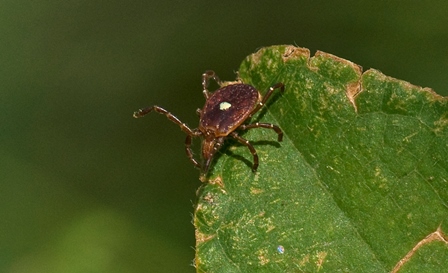Tick Control for Horses
Michael W. Dryden DVM, PhD, DACVM
University Distinguished Professor
Department of Diagnostic Medicine/Pathobiology
Kansas State University
 Summer in Kansas and throughout the Midwest means managing ticks on our horses and other animals through a variety of measures.
Summer in Kansas and throughout the Midwest means managing ticks on our horses and other animals through a variety of measures.
Tick control problems in horses during the spring and summer in Kansas can include mixed infestations with Amblyomma americanum (Lone star tick), Amblyomma maculatum (Gulf coast tick) and Dermacentor variabilis (American dog tick). In the fall in Kansas horses may be infested with Dermacentor albipictus (winter tick) or Ixodes scapularis (blacklegged tick).
The Lone star tick was once thought to be restricted to Texas, Oklahoma, Missouri and eastern Gulf Coast States. Now recognized as far north as Michigan and Wisconsin. This tick species is now extremely common in central and eastern Kansas. Expansion is directly linked to the phenomenal population growth of the White-tailed deer in Central and Eastern North America. It is characterized by white spot on posterior margin of scutum of females.
Gulf coast ticks commonly infest the insides of the ears of large mammals. These are found in Gulf Coast states up to Central, North central and Northeastern KS. Juvenile forms feed on migratory birds; cattle egrets; how the tick is spread. They are typically found in the ears of livestock in April – June.
Ticks are most commonly encountered where horses graze in grassy areas near ponds, in ravines and under trees. Here grass is lush, tick hosts such as deer and turkey are most plentiful and shaded areas are most conducive for tick survival.
To control tick populations, eliminate shrubs and other woody vegetation that provides habitat for tick hosts and ticks.
Burning of pastures may reduce tick numbers, but burning has not shown consistent results. We have seen situations where burning of pastures actually increased tick exposure. This may have resulted from livestock congregating (for grass, shade & water) in areas that did not burn well, grassy areas near ponds, in ravines and under trees where tick activity is highest.
It may be beneficial to temporarily fence livestock away from these areas in the spring during highest tick activity. There are no acaracides registered for treating grazing land.
Control of ticks on horses is often accomplished by direct applications of acaracides.
Whole body treatments
-
Permethrin: pour-ons and sprays (Some of these products can also be used in back rubbers.)
- Various brands including Brute, Permectrin II, Ultra Boss, etc.
- Apply sprays to penetrate entire hair coat. Permethrin products provide control for up to 2 or 3 weeks.
- See individual product fact sheets for specific details on application, mixing and restrictions.
- Canine formulation of permethrin-dinotefuran (Vectra 3D) has been approved (but not marketed) for horses. 8ml/400lbs may last 3 weeks.
-
Coumaphos:(Co-Ral)
- For use as a spray or in back rubbers.
- Spray for cattle or horses do not reapply sooner than 10 days. As a spray or for use in a back rubber.
- See individual product fact sheets for specific details on application, mixing and restrictions.
- Livestock insecticide spray for control of flies, lice and ticks in beef, dairy (including lactating), swine and horses.
-
Fipronil (Frontline Spray)
- Not approved, but has been widely used to treat mange in horses.
- Reports of tick control are varied, but often positive.
- Dampen hair on legs and affect areas (similar to how dogs are treated)